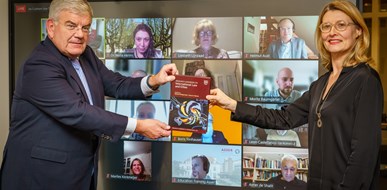Research Handbook on International Law and Cities awarded 2022 ESIL Collaborative Book Prize
Published 7 September 2022
@Hilko Visser - The Hague mayor Jan van Zanen and author Janne E. Nijman during the book launch of the Research Handbook on International Law and Cities in November 2021.
Associate fellow and former academic director of the Asser Institute Janne E. Nijman (University of Amsterdam) and Helmut Philipp Aust (Freie Universität Berlin) were awarded the 2022 ESIL Collaborative Book Prize for their book Research Handbook on International Law and Cities (Edward Elgar Publishing, 2021).
The jury called the book ‘fascinating’ and ‘thought-provoking’ and wrote: “It does push the reader to think about international law differently than before since the underlying phenomena and questions of the book are so interesting and the role of cities is convincingly and holistically set out.”
Growing global role of cities
In their ground-breaking Research Handbook on International Law and Cities, editors Helmut Aust and Janne E. Nijman shed light on the growing global role of cities, and build the case for a renewed understanding of international law, in light of this ‘urban turn’.
The volume, with contributions from an interdisciplinary group of scholars, maps the practice of cities in various fields of international law, ranging from climate change to human rights, migration, health governance, transportation and security governance. The book also offers reflections on how the foundations of international law are affected by this ‘urban turn’.
The Hague mayor Jan van Zanen was presented the first copy of the Research Handbook during a panel discussion with city network experts and international law scholars in November 2021.
From the 2022 ESIL Collaborative Book Prize jury report:
“Research Handbooks tend to be just that – a book for reading selected contents one is interested in. Not this Handbook – it is fascinating from the beginning to end. „Research Handbook of International Law and Cities”, edited by Helmut Philipp Aust and Janne E. Nijman, is an innovative collaborative work because it draws light at the growing importance of cities in international legal frameworks.
Traditionally, cities have had relatively little to do with international law as the law of nations was constructed around the nation state and its sovereignty. The book invites us to rethink this proposition as it demonstrates how cities have become active in areas traditionally thought to be relating to international law. It thus raises awareness of a blind spot in international law, filling a research gap – adding more actors to the multiplicity of actors relevant in international law. […]
Overall, the book impresses with the range of its perspectives, it accommodates 35 different chapters from a group of scholars who can be called diverse and also illustrate the value of best edited books which are together stronger and richer than each constitutive part would be alone. In this sense, the volume is thought-provoking in the best sense of the word. It does push the reader to think about international law differently than before since the underlying phenomena and questions of the book are so interesting and the role of cities is convincingly and holistically set out.”

